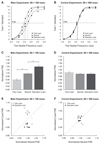Voluntary attention increases perceived spatial frequency
- PMID: 20675797
- PMCID: PMC2944222
- DOI: 10.3758/APP.72.6.1510
Voluntary attention increases perceived spatial frequency
Abstract
Voluntary covert attention selects relevant sensory information for prioritized processing. The behavioral and neural consequences of such selection have been extensively documented, but its phenomenology has received little empirical investigation. Involuntary attention increases perceived spatial frequency (Gobell & Carrasco, 2005), but involuntary attention can differ from voluntary attention in its effects on performance in tasks mediated by spatial resolution (Yeshurun, Montagna, & Carrasco, 2008). Therefore, we ask whether voluntary attention affects the subjective appearance of spatial frequency--a fundamental dimension of visual perception underlying spatial resolution. We used a demanding rapid serial visual presentation task to direct voluntary attention and measured perceived spatial frequency at the attended and unattended locations. Attention increased the perceived spatial frequency of suprathreshold stimuli and also improved performance on a concurrent orientation discrimination task. In the control experiment, we ruled out response bias as an alternative account by using a lengthened interstimulus interval, which allows observers to disengage attention from the cued location. In contrast to the main experiment, the observers showed neither increased perceived spatial frequency nor improved orientation discrimination at the attended location. Thus, this study establishes that voluntary attention increases perceived spatial frequency. This phenomenological consequence links behavioral and neurophysiological studies on the effects of attention.
Figures





References
-
- Anstis S. Adaptation to peripheral flicker. Vision Research. 1996;36:3479–3485. - PubMed
-
- Anton-Erxleben K, Abrams J, Carrasco M. Attention does alter apparent contrast: Evaluating comparative and equality judgments. Poster session presented at the 10th Annual Meeting of the Vision Sciences Society; Naples, Florida. 2010. May,
-
- Anton-Erxleben K, Henrich C, Treue S. Attention changes perceived size of moving visual patterns. Journal of Vision. 2007;7(11, Art. 5):1–9. - PubMed
-
- Balz GW, Hock HS. The effect of attentional spread on spatial resolution. Vision Research. 1997;37:1499–1510. - PubMed
Publication types
MeSH terms
Grants and funding
LinkOut - more resources
Full Text Sources
